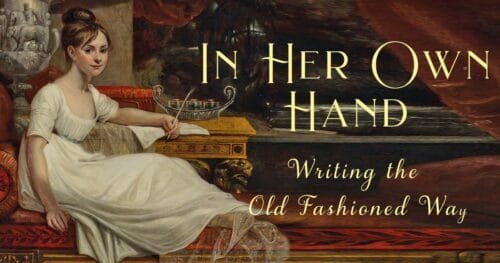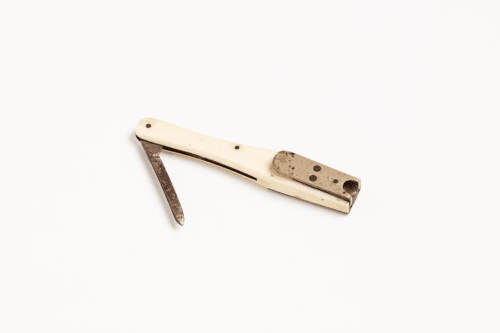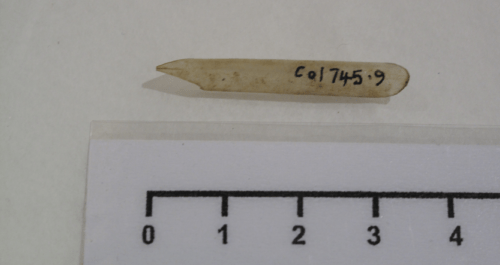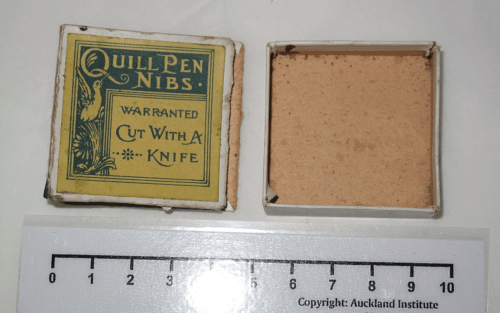The Challenge of Quill Pens

In honor of National Hand Writing Day, let’s have a look at what handwriting used to involve!
Whenever we think about writing in the ‘old days’ our minds go directly to the image of a quill pen. Quill pens date back to the Middle Ages, as far back as the 6th century. They were a vast improvement over their predecessor, the reed or cane pen, used for writing on papyrus, whose origins can be traced back to 800 BC. Reeds are brittle, do not retain a sharp point, and require about eight inches of usable material for writing. Since quills are more durable, hold a point longer and are useful until very little remains, they were a vast improvement over reeds, and are still in use today by some calligraphers.
Few of us use them today though, so the question: how did one use a quill pen and what was it like to write with one?
Beginning at the beginning

Jonathunder, GFDL 1.2 http://www.gnu.org/licenses/old-licenses/fdl-1.2.html, via Wikimedia Commons
Turning a feather into a pen was not as simple as finding a convenient bird, plucking a feather and dipping it in ink. The complex process began with acquiring the right feather.
Not just any feather was suitable for a quill pen. The best pens quills were those from primary flight feathers taken from large, living birds. (Feathers from living birds were much stronger.) Goose, turkey and swan feathers were highly prized for use as writing quills.
Goose feathers made the most popular pens for writing. Swan pens produced very broad lines. In contrast, crow feathers produced very fine, flexible pen nibs, favored by artists and ladies who wrote with small, delicate lines.
A healthy goose could produce about twenty pen-quills a year. Large flocks of geese were maintained for the sole purpose of producing pen-quills. But England could not keep up with its own demand for feathers, so a brisk feather trade developed. By 1835, twenty million quill feathers were imported from Europe, primarily Netherlands, Norway, Iceland, Germany, Russia and Poland.
Feather from the left wing were favored because the curve made them easier for right-handed writers to use. Left-handers preferred pens made from the right wing. Once gathered, the feathers were sorted into three grades: primes, seconds, and pinions, depending on the length and thickness of the quill.
Dressing the Quill
Once plucked, the feathers required tempering, which would strengthen and de-grease the feather’s barrel. Without this process, the quill cannot be cut into a clean slit that would allow ink to flow smoothly, essential to a proper pen nib.
Tempering or quill-dutching involved heating the quill shaft to harden it. This could be accomplished with hot ashes, hot water or hot sand. During this process, the quill might be flattened or shaped somewhat, and the outer and inner membranes would be removed. A more uniform appearance could be achieved with an aqua fortis (nitric acid) treatment, but some felt that resulted in brittle quills. So, many quills sold to clerks, who needed especially durable pens, were not treated.
Finally, the feathery part of the quill, the barbs, would be stripped away, in all or in part, making the quill far less showing but far more convenient to use and ship. Quills were then bundled up and send to stationers’ shops. They might be sold to consumers in this state, but more often pen cutters would prepare them for final sale.
Cutting a Quill
Cutting quills required particular skills, time and patience, which could be learned. Many books included instructions for the task. However, Dr. Parkins, Young Men’s Companion (1811) suggests:
THIS is gained sooner by Experience, and Observation from others who can make a Pen well, than by verbal Directions. …. After you have scraped the Quill, cut it at the End, half through, on the back Part, and then turning up the Belly, cut the other Part, or Half, quite through, about a quarter or almost half an inch, at the end of the Quill, which then appears forked…. The breadth of the Nib must be proportioned to the breadth of the Body, or (the) downright backstrokes of the Letters, in whatever hand you write.
~Parkins, 1811

Parkins was not referring to handedness here, but rather to which style of handwriting—of which there were several—on used (watch for an upcoming blog post on penmanship styles.) The different styles required different shaped pen nib, which would have to be cut to purpose. For example, the English Round Hand, which Jane Austen used, required an asymmetrical point on the nib.
Few people cut their own pens. Prepared pens, or just quill nibs, could be purchased in quantity, rather inexpensively, not unlike today’s ballpoint pens.
A small pen knife would be used to cut the quill. First, the quills natural point was removed at an angle, leaving an oval-shaped hole at the base of the barrel. When dipped in ink, this hole is where ink enters the barrel to flow into the nib.
The pen-cutter would then cut a 3/8” slit into the longer part of the barrel to lead the ink to the point of the nib through capillary action. Without this slit, the ink will not flow properly, dripping and blotting and making writing impractical.
Finally, the nib around the slit would be shaped with straight and angular cuts into the final desired form. At this point, pens were ready for sale.
You can watch how it was done here:
Pens might be sold in the form of the entire quill, but often quill nibs were sold alone. Nibs like this had been available for more than a century by the time Jane Austen was born. The nibs would be fit into a holder, which could be as simple or extravagant as the user desired. In 1810-1815 a box of twenty-five quill nibs cost three shillings. By 1822, one hundred could be bought for that same price.



Using a quill pen

Writing with a quill pen is a very different experience from writing with a modern fountain pen or ballpoint pen. Quill nibs are very delicate and cannot take the pressure of a heavy hand. So, writing would usually have been done over a felt cushion to preserve the pen’s tip as long as possible.
Several quills would have usually be used in writing a single document, not because the pens would wear out, but because, during the course of writing, the pen softens as ink is absorbed into the nib. When a pen became too soft, it would be wiped down and set aside to dry, while a new pen was pressed into service. As many as three or four quills might be required to write a letter.
Correct posture and hand position were required to keep the pen from wearing unevenly. Fast writing or too much hand pressure caused ink blots and sprays. Such bad habits would result in pens that needed to be mended or re-cut often. Most people mended their own pens, trimming away the dull and misshapen bits, to return them to their original shape.
Depending on one’s writing habits, a person could get a week’s worth of writing from a quill before there was not enough left of it to re-cut. Makes one wonder, how many quills Jane Austen would have used in a week, doesn’t it?
Find more on the art of writing here.
References
History of Quill Pens. History of Pencils. Accessed 11/21/22. http://www.historyofpencils.com/writing-instruments-history/history-of-quill-pens/
How to Ruin a Feather to Make a Pen. Her Reputation for Accomplishment. June, 21, 2014. Accessed 11/14/2022. https://herreputationforaccomplishment.wordpress.com/2014/06/21/how-to-ruin-a-feather-and-make-a-pen/
HURFORD, ROBERT. Handwriting in the Time of Jane Austen. PERSUASIONS ON-LINE V.30, NO.1 (Winter 2009). Accessed 11/28/22. https://jasna.org/persuasions/on-line/vol30no1/hurford.html
Kane, Kathryn. The Quill, the Regency Pen. Regency Redingote. September, 11, 2009. Accessed 11/01/22. https://regencyredingote.wordpress.com/2009/09/11/the-quill-the-regency-pen/
Manufacturing Quill Pens. Her Reputation for Accomplishment. June 19, 2014. Accessed 11/14/2022. https://herreputationforaccomplishment.wordpress.com/2014/06/19/manufacturing-quill-pens/
Parkins, Dr. Young Man’s Best Companion. Thomas Tego: London. 1811
Shaw, Ariel. Facts and History of Quill Pens. Pen’s Guide. April 5, 2019. Accessed 11/21/22. https://pensguide.com/facts-and-history-of-the-quill-pen/
The Pen in Penmanship. Her Reputation for Accomplishment. June 16, 2012. Accessed 11/14/2022. https://herreputationforaccomplishment.wordpress.com/2014/06/16/the-pen-in-penmanship/

When were pencils invented? Would those used for rough drafts rather than fussy pens?
According my my sources, pencils had been available since the 1500’s and were often in use. Because paper was very expensive, I do not expect that rough drafts were very common though.
I have been learning English Roundhand, otherwise known as Copperplate, for the past couple of years. I have personalized the style a bit to fit my esthetics, and while I have the lettering down fairly well, I need to practice my flourishes. I have pinned my Copperplate alphabet to my Facebook (https://www.facebook.com/susanne.barrett/) and linked on my Instagram at https://www.instagram.com/p/ChVTMohPlkf/?igshid=YmMyMTA2M2Y=
I use a metal nib inserted into a wooden holder and walnut ink for practice. I have some nice black Sumi ink for more formal projects — very smooth and creates raised letters that look like engraving. But one bottle of walnut ink lasted for nearly a year of almost daily practice.
I find writing this way of writing quite relaxing and stress-relieving as well as extremely satisfying. It’s definitely my passion project for the last two years.
Thanks for sharing this information, G!!
Warmly,
Susanne 🙂
Interesting article, with some points I did not know. That is always fun. Over my many years in the Society for Creative Anachronism (SCA) and in various Regency groups, I have taught classes in quill cutting. Most of my instruction was base on the several extant lessons from Medieval scribes. I’d like to trade information with other scribes, if anyone is interested. — Bjo Trimble (Maestra Flavia Beatrice Carmigniani in the SCA)